信息安全系统设计基础第十二周学习总结
【学习时间:8 小时】
【学习内容:process文件夹中的代码理解和执行、故障排除】
一、代码理解&执行(因为我的虚拟机无法共享文件,所以借用20135211李行之的电脑共同完成代码执行)
1.argv(文件夹)-argtest.c文件
#include <stdio.h>
#include <stdlib.h>
#include "argv.h"//该函数库中包括freemakeargv.c及makeargv.c函数的调用
int main(int argc, char *argv[])
{
char delim[] = " ";//制表符
int i;
char **myargv;//见下方解释
int numtokens;
if (argc != 2)//如果输入的命令字符个数不等于2,就输出标准错误
{
fprintf(stderr, "Usage: %s string
", argv[0]);
return 1;
}
if ((numtokens = makeargv(argv[1], delim, &myargv)) == -1)
{
fprintf(stderr, "Failed to construct an argument array for %s
", argv[1]);//翻译过来就是无法构造一个参数数组
return 1;
}
printf("The argument array contains:
");
for (i = 0; i < numtokens; i++)
printf("%d:%s
", i, myargv[i]);
execvp(myargv[0], myargv);
return 0;
}
另附加 freemakeargv.c及makeargv.c函数
#include <stdlib.h>
#include "argv.h"
void freemakeargv(char **argv) {
if (argv == NULL)
return;
if (*argv != NULL)
free(*argv);
free(argv);
}
/*-----------------------------------------------------------------------------*/
#include <errno.h>
#include <stdlib.h>
#include <string.h>
#include "argv.h"
int makeargv(const char *s, const char *delimiters, char ***argvp)//见下方解释
{
int error;
int i;
int numtokens;
const char *snew;
char *t;
if ((s == NULL) || (delimiters == NULL) || (argvp == NULL))
{
errno = EINVAL;
return -1;
}
*argvp = NULL;//把字符串数组置为空
snew = s + strspn(s, delimiters);//返回字符串s开头连续包含字符串delimiters内的字符数目
if ((t = malloc(strlen(snew) + 1)) == NULL)
return -1;
strcpy(t, snew);
numtokens = 0;
if (strtok(t, delimiters) != NULL)//关于strtok函数的用法见下方
for (numtokens = 1; strtok(NULL, delimiters) != NULL; numtokens++) ;
if ((*argvp = malloc((numtokens + 1)*sizeof(char *))) == NULL)
{//malloc函数请求分配了numtokens+1个字节的空间;如果是返回值是NULL说明分配不成功
error = errno;
free(t);//释放malloc函数给指针变量分配的内存空间的函数。使用后该指针变量一定要重新指向NULL。
errno = error;
return -1;
}
if (numtokens == 0)
free(t);
else
{
strcpy(t, snew);
**argvp = strtok(t, delimiters);
for (i = 1; i < numtokens; i++)
*((*argvp) + i) = strtok(NULL, delimiters);
}
*((*argvp) + numtokens) = NULL;
return numtokens;
}
关于该系列代码的难点理解
【1.为什么是* *myargv?】
经过查阅得知,比较准确的说法是: **相相当于二级指针,char **就是指向字符型指针的指针。最常使用的地方就是 int main(int argc,char **argv),相当于int main(int argc,char *argv[])。也就是说,可以看作是指向了字符串数组
【2.为什么是 int makeargv(const char *s, const char *delimiters, char * **argvp)】
把最后一个参数理解为向字符串数组取地址(从左到右,第一个代表取地址,后两个 **代表上文中说过的字符串数组)
【3.关于strtok函数?】
strtok函数用来将字符串分割成一个个片段,它的原型是char *strtok(charr s[],const char *delim)。只要在s中遇到delim中包含的字符(不一定是delim),就把这个字符改成�。每次调用成功后返回的都是被分割出的片段的指针。
【4.errno与error?】
前者是记录系统最后一次错误的函数;后者是系统错误
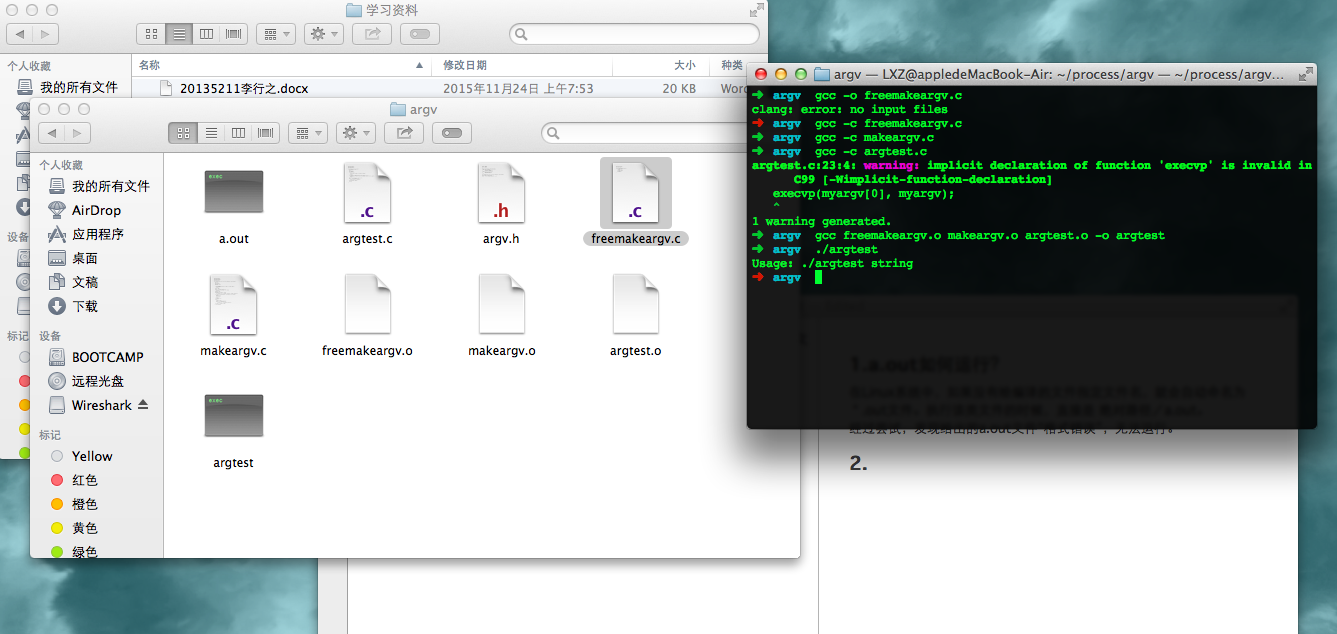
2.env文件夹-environ.c文件
#include <stdio.h>
#include <stdlib.h>
int main(void)
{
printf("PATH=%s
", getenv("PATH"));//getenv函数用来取得参数PATH环境变量的值,执行成功则返回该内容的指针
setenv("PATH", "hello", 1);//见下方解释
printf("PATH=%s
", getenv("PATH"));
#if 0
printf("PATH=%s
", getenv("PATH"));
setenv("PATH", "hellohello", 0);
printf("PATH=%s
", getenv("PATH"));
printf("MY_VER=%s
", getenv("MY_VER"));//版本
setenv("MY_VER", "1.1", 0);
printf("MY_VER=%s
", getenv("MY_VER"));
#endif
return 0;
}
【setenv函数的作用?】
setenv用来在本次函数运行的过程中增加或者修改环境变量。当最后一个参数不为0的时候,原来的内容会被修改为第二个参数所指的内容。

3.env文件夹-environvar.c文件
#include <stdio.h>
int main(void)
{
extern char **environ;
int i;
for(i = 0; environ[i] != NULL; i++)
printf("%s
", environ[i]);
return 0;
}
【environ变量是什么?】
该变量指向一个叫“environment”的字符串数组。包括USER(登录用户的名字),LOGNAME(与user类似),HOME(用户登录目录),LANG(地域名),PATH等

4.pipe文件夹-consumer.c文件
#include <stdio.h>
#include <stdlib.h>
#include <string.h>
#include <fcntl.h>
#include <limits.h>
#include <sys/types.h>
#include <sys/stat.h>
#define FIFO_NAME "/tmp/myfifo"
#define BUFFER_SIZE PIPE_BUF
int main()
{
int pipe_fd;
int res;
int open_mode = O_RDONLY;
char buffer[BUFFER_SIZE + 1];
int bytes = 0;
memset(buffer, 0, sizeof(buffer));
printf("Process %d opeining FIFO O_RDONLY
", getpid());
pipe_fd = open(FIFO_NAME, open_mode);
printf("Process %d result %d
", getpid(), pipe_fd);
if (pipe_fd != -1) {
do {
res = read(pipe_fd, buffer, BUFFER_SIZE);
bytes += res;
} while (res > 0);
close(pipe_fd);
} else {
exit(EXIT_FAILURE);
}
printf("Process %d finished, %d bytes read
", getpid(), bytes);
exit(EXIT_SUCCESS);
}
【1.PIPE_BUF的值是多少?】
4096字节
【2.memset函数用法?】
原型:memset(void *s,int ch,size_t n);将s中前n个字节用ch替换并返回s
【3.open函数用法?】
open(const char *pathname,int flags);第一个参数是欲打开的文件路径字符串,第二个参数是打开方式
【4.FIFONAME是什么?】
这里需要补充一下fifo的含义,它是一种文件类型,可以通过查看文件stat结构中的stmode成员的值来判断文件是否是FIFO文件。fifo是用来在进程中使用文件来传输数据的,也具有管道特性,可以在数据读出的时候清除数据。

5.env文件夹-producer文件
#include <stdio.h>
#include <stdlib.h>
#include <string.h>
#include <fcntl.h>
#include <limits.h>
#include <sys/types.h>
#include <sys/stat.h>
#define FIFO_NAME "/tmp/myfifo"
#define BUFFER_SIZE PIPE_BUF
#define TEN_MEG (1024 * 1024 * 10)
int main()
{
int pipe_fd;
int res;
int open_mode = O_WRONLY;
int bytes = 0;
char buffer[BUFFER_SIZE + 1];
if (access(FIFO_NAME, F_OK) == -1) {//检查文件是否有相应的权限
res = mkfifo(FIFO_NAME, 0777);//依据FIFO_NAME创建fifo文件,0777依次是相应权限
if (res != 0) {
fprintf(stderr, "Could not create fifo %s
",
FIFO_NAME);
exit(EXIT_FAILURE);
}
}
printf("Process %d opening FIFO O_WRONLY
", getpid());
pipe_fd = open(FIFO_NAME, open_mode);
printf("Process %d result %d
", getpid(), pipe_fd);
if (pipe_fd != -1) {
while (bytes < TEN_MEG) {
res = write(pipe_fd, buffer, BUFFER_SIZE);
if (res == -1) {
fprintf(stderr, "Write error on pipe
");
exit(EXIT_FAILURE);
}
bytes += res;
}
close(pipe_fd);
} else {
exit(EXIT_FAILURE);
}
printf("Process %d finish
", getpid());
exit(EXIT_SUCCESS);
}
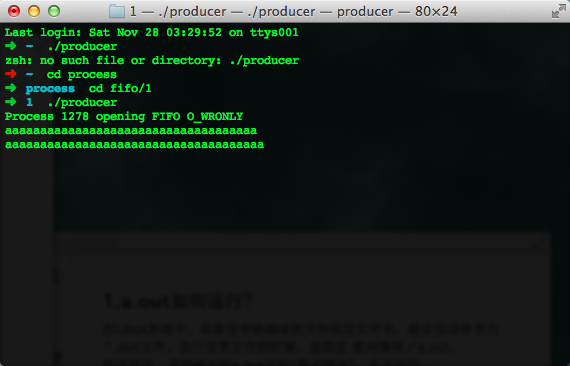

6.env文件夹-testmf.c文件
#include <stdio.h>
#include <stdlib.h>
#include <sys/types.h>
#include <sys/stat.h>
int main()//就是创建fifo文件
{
int res = mkfifo("/tmp/myfifo", 0777);
if (res == 0) {
printf("FIFO created
");
}
exit(EXIT_SUCCESS);
}

(修改testmf.c代码)

(修改之后的执行结果)
7.pipe文件夹-pipe.c文件
#include <stdio.h>
#include<stdlib.h>
#include <unistd.h>
#define oops(m,x) //当linux系统执行代码遇到问题时,就会报告oops
{ perror(m); exit(x); }
int main(int ac, char **av)
{
int thepipe[2], newfd,pid;
if ( ac != 3 ){//输入的命令长度不等于3
fprintf(stderr, "usage: pipe cmd1 cmd2
");
exit(1);
}
if ( pipe( thepipe ) == -1 ) //以下是各种错误
oops("Cannot get a pipe", 1);
if ( (pid = fork()) == -1 )
oops("Cannot fork", 2);
if ( pid > 0 ){
close(thepipe[1]);
if ( dup2(thepipe[0], 0) == -1 )
oops("could not redirect stdin",3);
close(thepipe[0]);
execlp( av[2], av[2], NULL);
oops(av[2], 4);
}
close(thepipe[0]);
if ( dup2(thepipe[1], 1) == -1 )
oops("could not redirect stdout", 4);
close(thepipe[1]);
execlp( av[1], av[1], NULL);
oops(av[1], 5);
}

8.pipe文件夹-stdinredir1.c文件
#include <stdio.h>
#include <fcntl.h>
int main()
{
int fd ;
char line[100];
fgets( line, 100, stdin ); printf("%s", line );//就是打印输入的字符串
fgets( line, 100, stdin ); printf("%s", line );
fgets( line, 100, stdin ); printf("%s", line );
close(0);
fd = open("/etc/passwd", O_RDONLY);
if ( fd != 0 ){//打开或者创建失败的时候才会执行
fprintf(stderr,"Could not open data as fd 0
");
exit(1);
}
fgets( line, 100, stdin ); printf("%s", line );
fgets( line, 100, stdin ); printf("%s", line );
fgets( line, 100, stdin ); printf("%s", line );
}
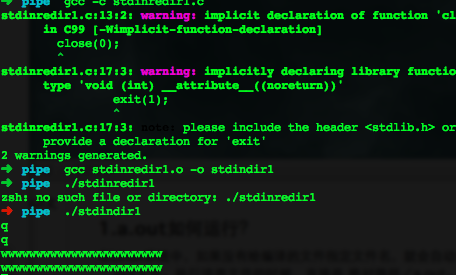
9.pipe文件夹-testtty.c文件
#include <unistd.h>
int main()
{
char *buf = "abcde
";
write(0, buf, 6);
}
【write函数】
write(int handle,void *buf,int nbyte); 第一个参数是文件描述符,第二个参数是指向一端内存单元的指针,第三个参数是要写入指定文件的字节个数;成功时返回字节个数,否则返回-1。

10.signal文件夹-sigactdemo1.c文件
#include <stdio.h>
#include<unistd.h>
#include <signal.h>
#define INPUTLEN 100
void inthandler();
int main()
{
struct sigaction newhandler;//见下方解释
sigset_t blocked; //信号集,用来描述信号的集合,与信号阻塞相关函数配合使用
char x[INPUTLEN];
newhandler.sa_handler = inthandler; //函数指针
newhandler.sa_flags = SA_RESTART|SA_NODEFER
|SA_RESETHAND; //sa_flags是一个位掩码。这里,第一个参数使得被信号打断的一些原语“正常返回”
sigemptyset(&blocked);
sigaddset(&blocked, SIGQUIT);
newhandler.sa_mask = blocked;
if (sigaction(SIGINT, &newhandler, NULL) == -1)
perror("sigaction");
else
while (1) {
fgets(x, INPUTLEN, stdin);
printf("input: %s", x);
}
return 0;
}
void inthandler(int s)
{
printf("Called with signal %d
", s);
sleep(s * 4);
printf("done handling signal %d
", s);
}
具体参见http://www.cnblogs.com/gogly/articles/2416989.html
【sigaction结构体,用来查询或设置信号处理方式。比如它指定了对特定信号的处理,信号所传递的信息,信号处理函数执行过程中应该屏蔽掉哪些函数等。】

11.signal文件夹-sigdemo1.c文件夹
#include <stdio.h>
#include <signal.h>
void f(int);
int main()
{
int i;
signal( SIGINT, f );
for(i=0; i<5; i++ ){
printf("hello
");
sleep(2);
}
return 0;
}
void f(int signum)
{
printf("OUCH!
");
}
这样的代码是无法在输出的时候体现出对f的调用的。我认为其中signal( SIGINT, f );这一句中,因为f的返回值是“void”,所以无法体现。
补充:signal函数,原型 signal(参数1,参数2);,其中参数1是我们进行处理的信号,参数2是我们处理的方式。

后来我对代码进行了修改,体现了对f函数的调用

12.signal文件夹-sigdemo3.c文件
#include <stdio.h>
#include<string.h>
#include <signal.h>
#include<unistd.h>
#define INPUTLEN 100
int main(int argc, char *argv[])
{
void inthandler(int);
void quithandler(int);
char input[INPUTLEN];
int nchars;
signal(SIGINT, inthandler);//^C
signal(SIGQUIT, quithandler);//^
do {//输入什么,就输出什么(在read函数不发生错误的情况下)
printf("
Type a message
");
nchars = read(0, input, (INPUTLEN - 1));
if (nchars == -1)
perror("read returned an error");
else {
input[nchars] = '�';
printf("You typed: %s", input);
}
}
while (strncmp(input, "quit", 4) != 0);//只有输入quit的时候才会退出
return 0;
}
void inthandler(int s)
{
printf(" Received signal %d .. waiting
", s);
sleep(2);
printf(" Leaving inthandler
");
}
void quithandler(int s)
{
printf(" Received signal %d .. waiting
", s);
sleep(3);
printf(" Leaving quithandler
");
}

13.exec3.c文件
#include <stdio.h>
#include <unistd.h>
int main()
{
char *arglist[3];
char*myenv[3];
myenv[0] = "PATH=:/bin:";
myenv[1] = NULL;
arglist[0] = "ls";
arglist[1] = "-l";
arglist[2] = 0 ;
printf("* * * About to exec ls -l
");
// execv( "/bin/ls" , arglist );
// execvp( "ls" , arglist );
// execvpe("ls" , arglist, myenv);
execlp("ls", "ls", "-l", NULL);
printf("* * * ls is done. bye
");
}
【execlp函数?】
从PATH环境变量中查找文件并执行。原型:int execlp(const char *file,const char *arg,……); 从PATH环境变量所指的目录中查找符号参数file的文件名,然后将第二个及以后的参数当作该文件的argv[0],argv[1],……,最后一个参数必须用NULL结束。
【execv函数?】
原型:int execv(const char *pathname,char *const argv[]);装入并运行其他程序 对比:execvp函数原型: int execvp(const char *file,char *const argv[]);
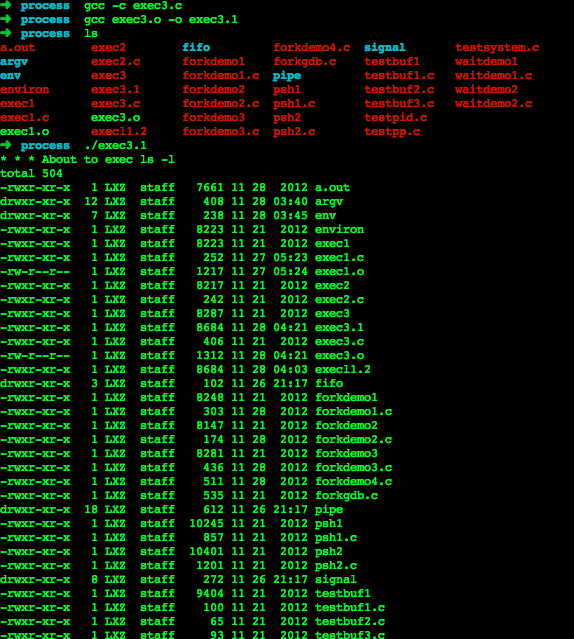
二、关于执行时的困难&解决
1.a.out如何运行?
在Linux系统中,如果没有给编译的文件指定文件名,就会自动命名为*.out文件。执行该类文件的时候,直接是 绝对路径/a.out。 经过尝试,发现给出的a.out文件“格式错误”,无法运行。 后经依次尝试,发现给出的所有可执行文件都有类似的问题。这个问题的原因在下面的操作中逐渐得到了解答。
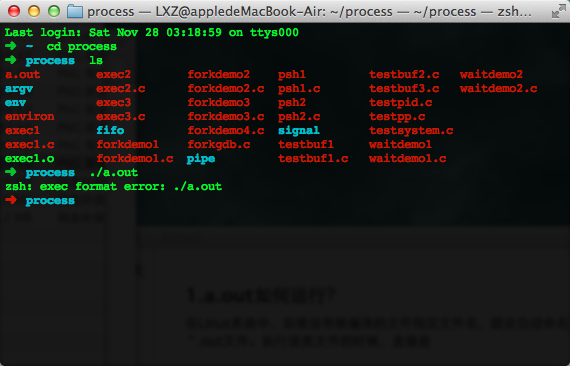

(选择打开方式为“在终端执行”)
2.如何在linux中执行.sh文件?
(参考http://zhidao.baidu.com/question/1733278229438599307.html)
首先你要让文件有能够执行的权限,比如你的文件是a.sh那么你可以 chmod +x a.sh 然后运行文件就可以了 ./a.sh 这样运行是a.sh在当前工作目录,如果文件没在当前目录,那么就需要用绝对路径来执行,比如 /opt/a.sh /opt/test/a.sh
3.关于指针数组与数组指针的区别?
(参考http://www.cnblogs.com/mq0036/p/3382732.html)
-
数组指针(也称行指针)
- 定义 int (*p)[n];()优先级高,首先说明p是一个指针,指向一个整型的一维数组,这个一维数组的长度是n,也可以说是p的步长。也就是说执行p+1时,p要跨过n个整型数据的长度。
-
如要将二维数组赋给一指针,应这样赋值:
int a[3][4]; int (*p)[4]; //该语句是定义一个数组指针,指向含4个元素的一维数组。 p=a;//将该二维数组的首地址赋给p,也就是a[0]或&a[0][0] p++; //该语句执行过后,也就是p=p+1;p跨过行a[0][]指向了行a[1][] -
数组指针也称指向一维数组的指针,亦称行指针。
-
指针数组
- 定义 int p[n];[]优先级高,先与p结合成为一个数组,再由int说明这是一个整型指针数组,它有n个指针类型的数组元素。这里执行p+1时,则p指向下一个数组元素,这样赋值是错误的:p=a;因为p是个不可知的表示,只存在p[0]、p[1]、p[2]...p[n-1],而且它们分别是指针变量可以用来存放变量地址。但可以这样 p=a; 这里p表示指针数组第一个元素的值,a的首地址的值。
-
如要将二维数组赋给一指针数组:
int *p[3]; int a[3][4]; p++; //该语句表示p数组指向下一个数组元素。注:此数组每一个元素都是一个指针 for(i=0;i<3;i++) p[i]=a[i];这里int *p[3] 表示一个一维数组内存放着三个指针变量,分别是p[0]、p[1]、p[2] 所以要分别赋值。
4.关于函数指针和指针函数的区别?
参考(http://blog.csdn.net/htyurencaotang/article/details/11490081)
-
指针函数是指带指针的函数,即本质是一个函数。函数返回类型是某一类型的指针
-
类型标识符 *函数名(参数表) ;具体格式:int *f(x,y);
-
首先它是一个函数,只不过这个函数的返回值是一个地址值。指针函数一定有函数返回值,而且在主调函数中,函数返回值必须赋给同类型的指针变量。例如:
01.float *fun(); 02.float *p; 03.p = fun(a);
-
-
函数指针是指向函数的指针变量,即本质是一个指针变量。
- 指向函数的指针包含了函数的地址,可以通过它来调用函数。声明格式如下: 类型说明符 (*函数名)(参数)
-
使用的时候:
01.int (*f)(int x); /*声明一个函数指针 */ 02.f=func; /*将func函数的首地址赋给指针f */
5.execl1执行故障?
在直接 gcc execl1 -o execl1.2(因为之前已经有execl可执行文件了)之后,系统提示如图。后来改变方法,先生成.o 文件再生成可执行文件,就可以执行代码了。

通过网上搜索,发现出现这个错误提示是因为使用了第三方库而没有把它的.m文件添加到compile source中去,而是可能只把这些文件copy到当前文件夹里就觉得可以了;这样在直接编译链接执行的时候根本没有自动引用(网上提供的解决方法建立在专门的编写软件基础上,在target--build phases--compile source中添加.m;不过针对我们的情况,可以分步完成以保证最终生成可执行文件)。
6.consumer执行故障?
开始的时候直接gcc consumer.o -o consumer仍然出现上文中的错误。后来删除consumer .o 文件之后分步编译,可以执行。
7.producer.c函数运行错误?
开始的时候,提示有错误。如图。 后来查询了access函数,发现它的功能是确定文件或者文件夹的访问权限。如果指定的存取方式有效,则返回0;否则返回-1.其中,f_ok只是判断该文件是否存在。而整个函数需要头文件<unistd.h>。加上该头文件之后,代码可以正常编译。
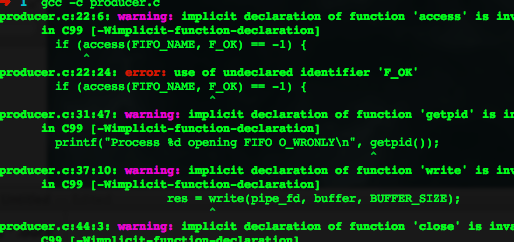
三、其他代码执行结果
(fifo文件夹-c,p,tags代码执行)

(forkdemo1.c执行)

(forkdemo2.c文件)

(forkdemo3.c执行)

(forkdemo4.c执行)
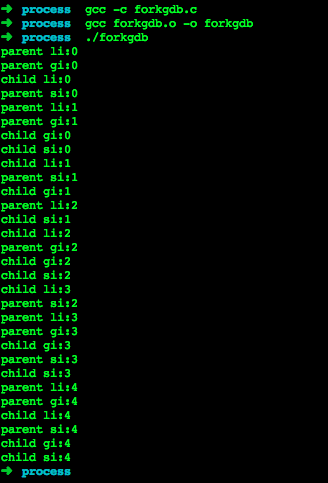
(forkgdb.c执行)

(listargs.c代码执行)

(pipe.c代码执行)

(pipedemoo2.c代码执行。其中,其主体结构为do……while(1),是一个无法停止的循环。可以用ctrl+C强制退出代码执行)
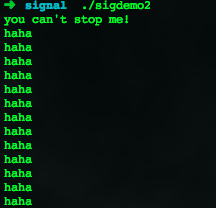
(sigdemo2.c代码执行,同上)
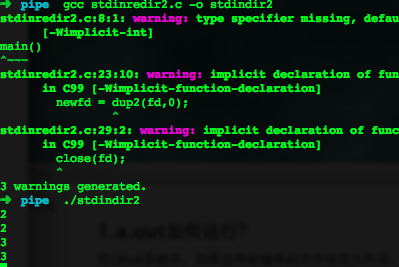
(stdindir2.c代码执行)

(testbuf1.c代码执行)

(testpid.c代码执行)

(testpp.c代码执行;并没有结果输出,知识申请了一个20字节大小的空间)

(waitdemo1.c代码执行)

(waitdemo2.c代码执行)
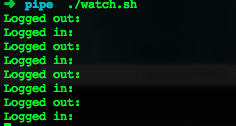
(watch.sh程序,每sleep30秒打印一次)

(watch2.sh程序,结果同上)
四、疑问
1.关于argtest.c代码
snew = s + strspn(s, delimiters);//返回字符串s开头连续包含字符串delimiters内的字符数目
if ((t = malloc(strlen(snew) + 1)) == NULL)
return -1;
strspn函数返回的是字符个数,怎么再加上字符串s ?
2.res = mkfifo(FIFO_NAME, 0777);我知道0777是对应的权限;然而这四个数字分别对应哪些用户的权限?
补充:每个文件的三组权限(拥有者,所属用户组,其他用户,记住这个顺序是一定的)
3.sigactdemo1.c代码:
newhandler.sa_handler = inthandler; 这样赋值对吗?(原型是void inthandler(int s);)
五、心得
这次学习过程与之前有着很大的不同。就像我在期中总结的时候说的那样,我在实践方面需要进一步加强;这次如此多的代码的执行正好很好地锻炼了我的动手能力。比起理解代码,动手让代码“跑出来”更需要自己动脑筋(百科里会有对某个函数的详细解释,但很少有对某段代码如何运行的教程)。
